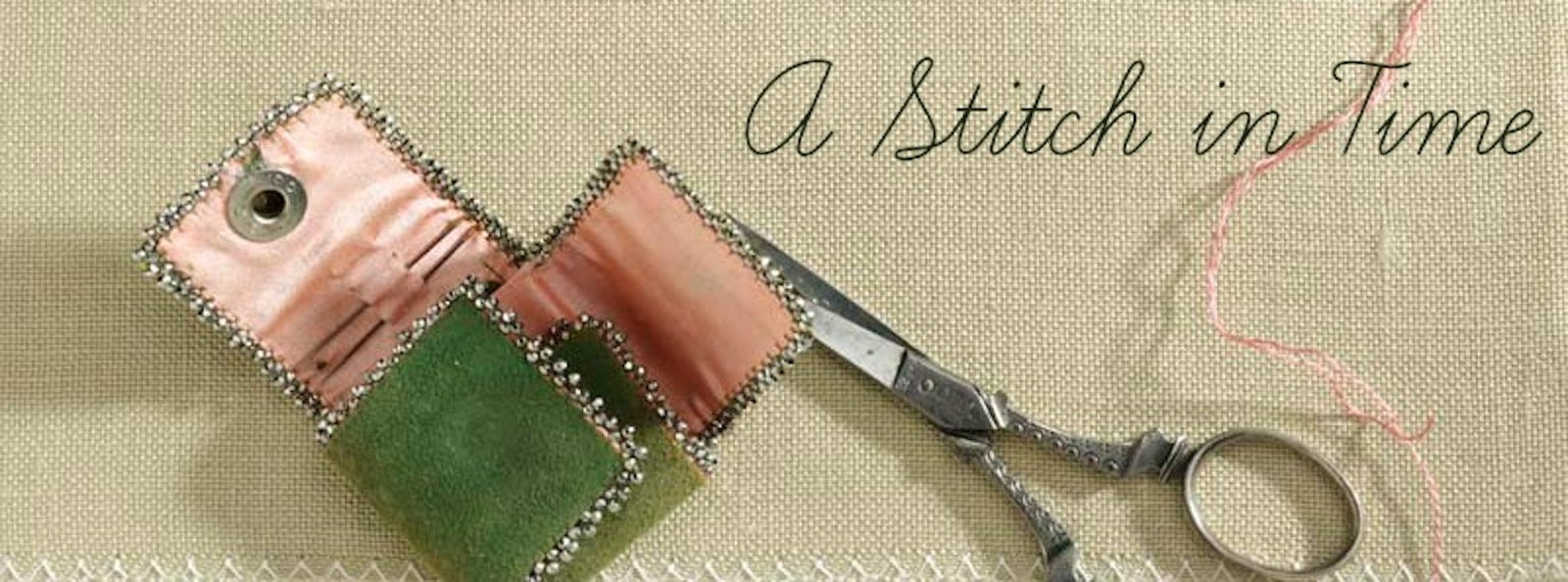The knitting stitch, a double row of straight stitches slanting in opposite directions, forms a solidly stitched, braidlike pattern on a canvas or fabric surface, and resembles true knitting. Other names for the knitting stitch include kalem, kelim, kilim, knit, knitting gobelin, and tapestry. Kelim is the Turkish word for “prayer rug,” and kalem and kilim are simply different spellings of the word. The thin and soft kelim rugs of Persia (present-day Iran) were actually woven in the tapestry style—not knotted. When the knitting stitch is worked closely with a fine thread, it produces an appearance similar to a woven tapestry; hence, the tapestry moniker.
The knitting stitch produces excellent thread coverage on the back of canvas and creates a hardwearing surface; it is sometimes used for floor rugs. And, as author and designer Eileen Bennett explains in A Note Book of Sampler Stitches (Jenison, Michigan: Eileen J. Bennett, 1990), the knitting stitch, which appears on some samplers, may have been an exercise for teaching schoolgirls to repair fabrics.
The knitting stitch may resemble a chain stitch, but the chain stitch is worked quite differently from the knitting stitch. While generally considered a canvas stitch, worked on either mono or double mesh canvas, the knitting stitch works equally well on evenweave linen, and—with careful placing of the needle (i.e., aligning the stitching in rows of equal width with stitches placed the same distance apart)— on nonevenweave fabrics, although stitching on the latter is not common.
The knitting stitch is easy to stitch and works up fairly quickly. It requires two separate trips or journeys and may be worked over one or two fabric threads in width and one to four threads in height; the usual configuration is one thread wide and two to four threads high (Figures 1 and 3). Illustrated here are four of the most common stitching sequences: beginning at the top of the row on the left side (Figure 1); beginning at the top but on the right side (Figure 2); beginning at the bottom of the row on either the left or right side (Figures 3 and 4, respectively).
Depending on how you want the stitch to look in a design, you may add short compensating stitches between the top two and bottom two stitches to fill in the small gaps (Figure 5).
Although the knitting stitch usually appears vertical (Figures 1–5) or horizontal (Figures 6 and 7), it may be worked diagonally (Figure 8). Regardless of the stitch direction or size, be sure to keep the tension of the stitch even to prevent an untidy appearance. Use any thread for the knitting stitch that enables it to maintain its visual character— the double row of straight stitches slanting in opposite directions—as long as the thread itself is suitable for the background fabric or canvas. A fuzzy or multistranded thread is more likely to obscure the stitch’s pattern, but this may be desirable if you want to convey the texture of knitted motifs. Experiment using different fibers to see how easily they alter the stitch’s appearance.
The knitting stitch is suitable for borders (Figure 9), bands, stripes, and fillings for small or large shapes and even entire background areas. In pictorial designs, its unique pattern is perfect for illustrating the knitted textures of mittens, sweaters, braided rug motifs, and hair braids. Create interesting shading by stitching the two journeys in two different colors or different shades of the same color, or intersperse different colors or shades within the same journey for more subtle shading.
For centuries, needleworkers have used the easily recognizable and easy-to-do knitting stitch in creative ways. Try it for yourself. Deanna
This second installment of Deanna’s stitch tutorials originally appeared in the March/April 2002 issue of PieceWork, along with instructions for stitching lovely monograms, using padded satin stitch. Deanna is PieceWork’s needlework technical editor; she previously was the editor of The Needleworker magazine. Stay tuned for more stitch tutorials from Deanna in the weeks ahead! Read the entire "Stitch in Time" series!
Featured Image: Scissors and needle case courtesy of Loene McIntyre. Photo by Joe Coca.






